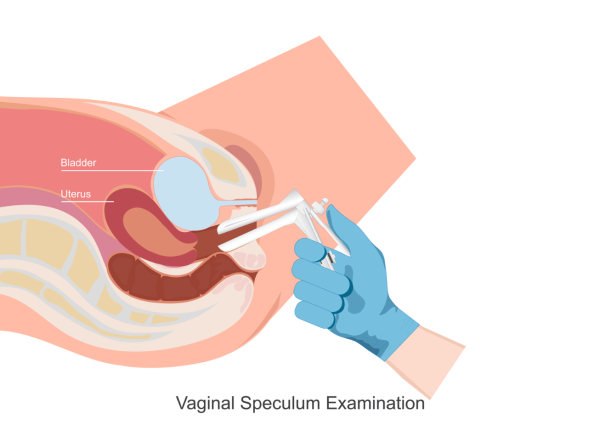Wishing everyone a safe and happy Christmas and New Year – Meri Kirihimete from the Healthify team.
Pelvic examination
Also called a vaginal examination or pelvic exam
Key points about a pelvic examination
- A pelvic examination is a check of a woman’s reproductive system. The healthcare provider feels your abdomen (kōpū, puku).
- A full exam includes checking your vulva (the skin around the opening to your vagina), looking inside your vagina up to your cervix (the neck of the womb), and feeling your ovaries and uterus (womb, whare tamariki).
- A pelvic exam may be done to check for a gynaecological (women’s health) problem, for STIs (sexually transmitted infection), or when you’re pregnant.
- A pelvic exam can be uncomfortable and you may feel embarrassed but there are ways of making it easier.

A pelvic exam is when a healthcare provider checks the parts of your reproductive system. This includes your vagina, cervix (neck of your womb), fallopian tubes, vulva (skin around the opening to your vagina), ovaries and uterus. Some parts, such as your vagina and cervix, can be looked at. Others are examined by palpating (feeling) your abdomen (tummy, puku).

Image credit: Openclipart
Pelvic examinations can be done for many reasons, including:
- if you have unusual bleeding or discharge
- if you’re pregnant and have bleeding or pain
- if you have vaginismus – an involuntary tightening of the vagina which can cause pain with penetration, such as with sexual intercourse or inserting a tampon
- if you have symptoms of a prolapse such as incontinence – passing urine involuntarily – or feeling ‘something coming down’ between your legs
- to check for swelling in your pelvis due to a cyst, a cancer or a fibroid
- if you might have a sexually transmitted infection (STI)
- if you had an abnormal cervical screening test result.
If you don’t already know the person doing the exam, there will be time for introductions before it starts. You’ll be able to talk to them about any concerns you may have and ask questions. It’s important that what happens is right for you. This may be:
- having a person of a particular sex doing the examination
- having a medical observer (used to be called chaperone)
- having an interpreter if needed
- having a friend or member of your whānau with you
- feeling respected and safe to have the examination done
- saying a karakia or prayer
- making sure you understand what is happening and that you freely give your permission.
Before the examination you will be asked to remove your lower clothing and will be given a robe or a blanket to cover you. You should be given privacy while you undress.
The examination
A full examination has 3 parts – a visual examination of your vulva, an internal examination where the healthcare provider looks inside your vagina at your cervix, and a bimanual exam where the examiner feels the inside and presses your tummy at the same time to feel your internal organs. However, depending on the reason for your examination, not all of these may be done.
During the exam you will have to lie on a table and let your knees drop open to the sides. You may be asked to pull your heels up towards your bottom, or you may be asked to put your feet into special rests called stirrups.
Visual exam
Your healthcare provider can examine the outside of your vagina – the vulva – to check the condition of your skin and look for any rashes or other visible problems.
Bimanual exam
The healthcare provider may need to feel your cervix, uterus and ovaries. To do this they put on gloves, then rest one hand on your abdomen and put 1 or 2 lubricated fingers inside your vagina. By putting gentle pressure on your tummy they can feel the size, shape and texture of your reproductive organs. It’s called bimanual because they use both hands.
Internal exam
If your healthcare provider needs to see what’s happening inside you, they will insert a medical tool called a speculum into your vagina. It's made of plastic and has a light attached. It has 2 halves which can be gently spread apart so they can see your cervix (at the top of your vagina) or collect a sample of cells for testing.

Image credit: Depositphotos
Once it’s over you’ll be given tissues to wipe off any lubricating gel and will be able to get dressed again. The examination can be uncomfortable, and embarrassing, but shouldn’t be painful. However, if you’re feeling tense and anxious it can make it more uncomfortable.
There are things you can do to relax and make it easier.
If you’re worried about having a pelvic exam, here are some things you can try to make it more comfortable and easier.
Before your appointment
- If you no longer have menstrual periods (your monthly bleeding has stopped) and have problems with vaginal dryness you can ask for a prescription for oestrogen vaginal cream (Ovestin) to use for a few weeks before you have your vaginal exam.
- Write down any questions you have so you remember to ask them.
- Arrange to take somebody with you for support.
During the appointment
- Make sure your bladder is empty.
- Make sure you feel comfortable with the healthcare provider doing the test. If you’d prefer somebody else to do it you have the right to ask.
- Have your support person come in with you. They could sit beside you and hold your hand or talk to you and distract you during the exam.
- Talk to the person doing the exam. Tell them you’re worried and ask them to do whatever makes it easier for you. This may include:
- you telling them if something has happened in the past to make you feel anxious, eg, a history of sexual assault or a difficult pelvic examination
- them using a smaller speculum to make it less uncomfortable
- them letting you put the speculum in for yourself if you’d prefer, or putting your hand over theirs to guide the speculum in
- them using plenty of lubricating gel (you may be able to bring your own)
- them telling you exactly what they’re going to do and what it will feel like
- them being prepared to stop as soon as you ask them to
- you asking them to go slowly so you have time to relax.
- If you’ve been told that your cervix is high up or hard to see in a previous exam, putting your fists, a pillow or folded blanket under your bottom can help.
- If you find it difficult to lie on your back with your legs apart (for any reason) it's possible to try a different position. Let the person doing the exam know if you're in discomfort or pain.
- Try some breathing exercises to help you relax and to relax your pelvic floor muscles so the examination is easier.
- Diaphragmatic breathing can help with relaxing you and also relaxing the pelvic floor muscles which surround the lower part of your vagina. Breathe in and out slowly, feel your ribs and tummy expanding as you breathe in.
- Push out your tummy to make it as big as possible (as if you had a beer gut!). Pushing your tummy muscles out also makes your pelvic floor muscles bulge out and relax. It’s a good thing to do as the speculum is being put in.
- Try imagining you’re somewhere else – at the beach listening to the waves or lying in the garden watching the clouds overhead.
References
- Experiencing pain during your gynecology exam? Here’s what you can do(external link) Ochsner Health, US, 2022
- Pelvic exam(external link) Healthline, US, 2017
- Gynaecological examination(external link) CDHB Clinical Skills Unit, NZ, 2013
Gynecological pelvic examination(external link) StatPearls, US, 2024
Gynaecological examination(external link) CDHB Clinical Skills Unit, NZ, 2013
Gynaecological examinations and procedures(external link) RANZCOG, 2020
Cook C, Clark T, Brunton M. Optimising cultural safety and comfort during gynaecological examinations – accounts of indigenous Māori women(external link) Nursing Praxis NZ 2014;30(3):19–34
Speculum examination(external link) Geeky Medics, UK, 2024
The pelvic exam – multiple positions for patient-centered care(external link) Reproductive Health Access Project, US, 2024
Credits: Healthify editorial team. Healthify is brought to you by Health Navigator Charitable Trust
Reviewed by: Dr Alison Payne, Specialist General Practitioner, Martinborough
Last reviewed:





